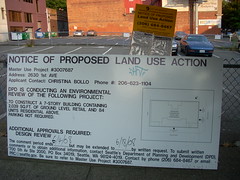In thousands of planning and zoning laws across the nation, official announcements are required to be published in the local newspaper of "general circulation." In an era of newspaper decline and expanding diversity of media, are these laws becoming obsolete? Furthermore, should we be concerned with newspapers at all if a newer, more universally accessible medium is available: the Internet? A variety of announcements are legally required to be published in a local periodical of "general circulation," sometimes in addition to being published in an official government gazette. The practice entered the planning world through the U.S. Department of Commerce's highly influential standard zoning and planning enabling acts.
In thousands of planning and zoning laws across the nation, official announcements are required to be published in the local newspaper of "general circulation." In an era of newspaper decline and expanding diversity of media, are these laws becoming obsolete? Furthermore, should we be concerned with newspapers at all if a newer, more universally accessible medium is available: the Internet?
A variety of announcements are legally required to be published in a local periodical of "general circulation," sometimes in addition to being published in an official government gazette. The practice entered the planning world through the U.S. Department of Commerce's highly influential standard zoning and planning enabling acts.
The standard zoning act required any zoning amendment be heard before a public meeting, and "at least 15 days' notice of the time and place of such hearing shall be published in an official paper, or a paper of general circulation, in such municipality." The planning act's language was similar, requiring before a new plan could be adopted a "notice of the time and place of which shall be given by one publication in a newspaper of general circulation in the municipality and in the official gazette, if any, of the municipality."
 Published in 1926 and 1928, these acts influenced subsequent state laws across the nation. State and local laws often take a number of additional approaches to ensure the public has a reasonable opportunity to be heard in these proceedings. They include physical signs (such as this one from Seattle), notices posted on a prominent spot at city hall, or mailings to adjoining or other property owners.
Published in 1926 and 1928, these acts influenced subsequent state laws across the nation. State and local laws often take a number of additional approaches to ensure the public has a reasonable opportunity to be heard in these proceedings. They include physical signs (such as this one from Seattle), notices posted on a prominent spot at city hall, or mailings to adjoining or other property owners.
However, among these, the requirement to publish in a newspaper is unique in its reach. Regular citizens may not pass by every property or even visit city hall, but many will subscribe to the newspaper. Historically the term "general circulation" has evaded close definition, perhaps since in most communities tradition has established what local paper qualifies - usually a general daily or weekly. Citing two cases, an Indiana state legal memorandum defined the term as referring to papers with a diversity of subscribers, not simply a high circulation.
This means that although many newspapers are suffering declining relevance and circulation, their status as general circulation publications is not in danger so far as the law is concerned. However, I propose a new approach to public notice: the Internet. The Internet is available at any time and place there is a connection. Access in public schools and libraries is nearly universal. Additionally, it has fast become the resource of first resort for a wide variety of citizens. Although not every citizen may have access to the Internet, I have argued before that putting information on the web can raise the general level of awareness by improving the knowledge of journalists, activists, civic leaders, and others who are engaged in disseminating information.
Although many governments do a good job making information available, the quality is unfortunately uneven and many communities do not post information in a timely way. (In June I discussed this fact in the context of a related argument governments should focus on providing data only.) Requiring online notices in addition to or in the place of newspaper ads through a state law will ensure uniformity, and harness new technology to capture the intent of our existing planning and zoning laws in a changing world.

Analysis: Cybertruck Fatality Rate Far Exceeds That of Ford Pinto
The Tesla Cybertruck was recalled seven times last year.

National Parks Layoffs Will Cause Communities to Lose Billions
Thousands of essential park workers were laid off this week, just before the busy spring break season.

Retro-silient?: America’s First “Eco-burb,” The Woodlands Turns 50
A master-planned community north of Houston offers lessons on green infrastructure and resilient design, but falls short of its founder’s lofty affordability and walkability goals.

Test News Post 1
This is a summary

Analysis: Cybertruck Fatality Rate Far Exceeds That of Ford Pinto
The Tesla Cybertruck was recalled seven times last year.

Test News Headline 46
Test for the image on the front page.
Urban Design for Planners 1: Software Tools
This six-course series explores essential urban design concepts using open source software and equips planners with the tools they need to participate fully in the urban design process.
Planning for Universal Design
Learn the tools for implementing Universal Design in planning regulations.
EMC Planning Group, Inc.
Planetizen
Planetizen
Mpact (formerly Rail~Volution)
Great Falls Development Authority, Inc.
HUDs Office of Policy Development and Research
NYU Wagner Graduate School of Public Service


























